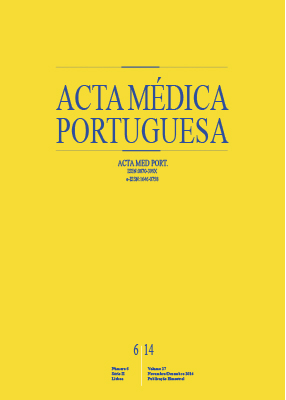Foreign Body Ingestion: Rare Cause of Cervical Abscess
DOI:
https://doi.org/10.20344/amp.5371Abstract
Introduction: Foreign body ingestion is a frequent emergency occurrence. Serious complications, although rare, include pharyngooesophageal perforation, aorto-oesophageal fistula and deep neck infection.
Material and Methods: A retrospective review was performed of all cases of foreign body ingestion requiring hospitalization between 1989 and 2011, in a tertiary Hospital. Cases complicated by deep cervical abscess were selected and their clinical presentation, results of diagnostic exams, therapeutics and clinical evolution are presented.
Results: Among a total of 1679 cases, 319 were related to pediatric patients and 1360 to adults. Two cases were reported (0.12%): an adult, 41 years-old, with parapharyngeal abscess subsequent to fishbone ingestion, and a child, 13 months-old, with retropharyngeal abscess consequent to chicken bone ingestion. Complications appeared three and four days after foreign body removal, respectively. In both situations cervical computerized tomography scan with contrast and surgical drainage were accomplished; the child was also submitted to rigid esophagoscopy for residual foreign body removal and closure of the associated pharyngeal laceration.
Discussion: Deep cervical abscesses are an uncommon but possible complication of foreign body ingestion and constitute a diagnostic challenge, particularly in children. Previous oesophageal manipulation by flexible endoscopy may be considered a risk factor for such complication. Imagiological studies proved to be crucial for diagnosis and therapeutic planning.
Conclusion: Although a rare complication, given a recent history of foreign body ingestion/removal and the presence of compatible symptoms, cervical abscesses should be taken into account, highlighting their potential morbimortality in the absence of an appropriate therapeutic approach.
Keywords: Foreign Body; Abscess; Esophagoscopy; Neck.
Downloads
Downloads
Published
How to Cite
Issue
Section
License
All the articles published in the AMP are open access and comply with the requirements of funding agencies or academic institutions. The AMP is governed by the terms of the Creative Commons ‘Attribution – Non-Commercial Use - (CC-BY-NC)’ license, regarding the use by third parties.
It is the author’s responsibility to obtain approval for the reproduction of figures, tables, etc. from other publications.
Upon acceptance of an article for publication, the authors will be asked to complete the ICMJE “Copyright Liability and Copyright Sharing Statement “(http://www.actamedicaportuguesa.com/info/AMP-NormasPublicacao.pdf) and the “Declaration of Potential Conflicts of Interest” (http:// www.icmje.org/conflicts-of-interest). An e-mail will be sent to the corresponding author to acknowledge receipt of the manuscript.
After publication, the authors are authorised to make their articles available in repositories of their institutions of origin, as long as they always mention where they were published and according to the Creative Commons license.









